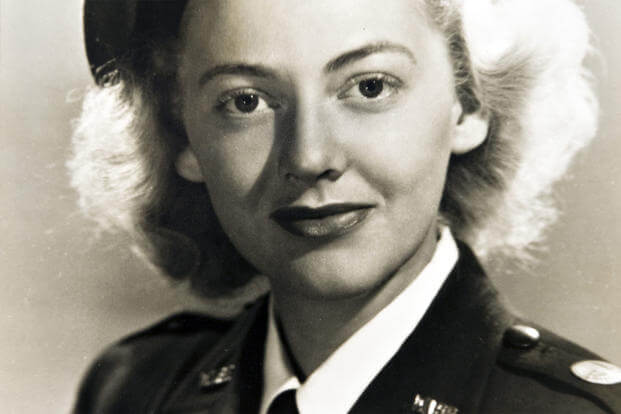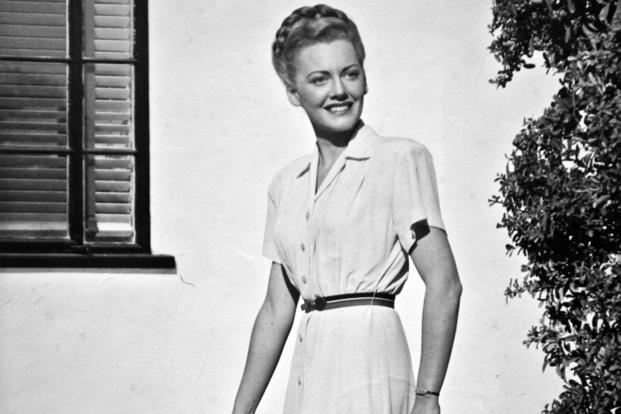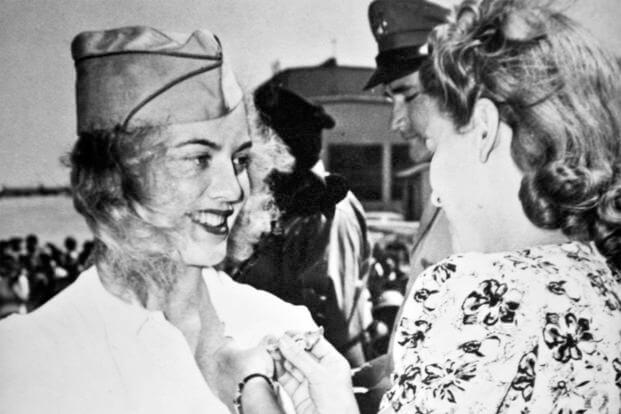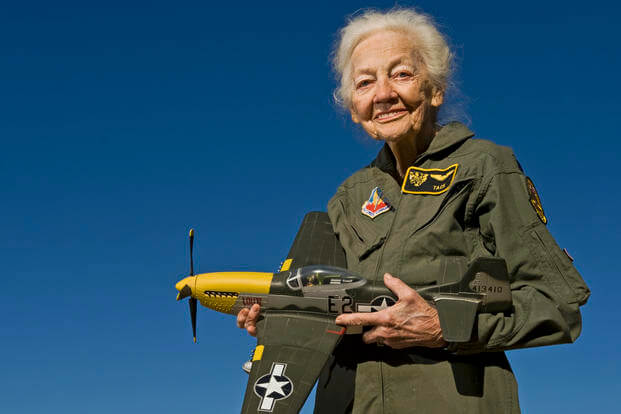A young female pilot showed her then-91-year-old guest the F-16 Fighting Falcon she flew at Luke Air Force Base, Arizona. The younger pilot thanked Betty “Tack” Blake several times as she talked about her job, so Blake finally asked the young captain why she was thanking her.
“Because you started it,” the captain said. “If you hadn’t been successful, we wouldn’t be doing what we’re doing today.”
Blake, who died April 9, 2015, at the age of 94, was believed to be the last surviving graduate of the first Women’s Airforce Service Pilot (WASP) training class during World War II.
“I feel very blessed to have been there at the beginning and gotten in,” Blake said in an interview with Airman magazine before her death. “It’s been an exciting life from a little kid who grew up on the beach in Honolulu.”
The WASPs flew aircraft ferrying and delivery missions, towed aerial targets, and participated in flight testing and evaluation of advanced jet and rocket-powered aircraft. The women replaced male pilots so they could fill combat roles.

Bernice “Bee” Falk Haydu, another Women’s Airforce Service pilot who now lives in New Jersey, served in the training command while Blake was in the Ferry Command, but she recalled her as “a very accomplished pilot."
“She liked to tell the story about how she and about 20 male pilots were delivering [Vultee BT-13 Valiants] some place,” Haydu said. “They were flying as a group, and then you’d have to land before sunset, not ferrying at night, and then you’d have to find a hotel, and it was difficult. But advance information had been sent that this group was coming and that they would need hotel rooms.
“So they all got the same key for the same room. She went down to the desk, and she said, ‘I don’t want to sleep with 20 men.’ So they said, ‘Well, we’ll see if we can get you something else.’ All of the other hotels were booked, so she said she went up, got in her bunk and she didn’t take one stitch of clothes off. She slept in her clothes all night. That’s the way things were in those days.”
Blake’s class began with 38 female pilots on Nov. 16, 1942, but only 23 graduated on April 24, 1943. They weren’t known as WASPs until the merging of the Women’s Flying Training Detachment and Women’s Auxiliary Ferrying Squadron on Aug. 5, 1943.
“We were an experiment,” Blake said. “We were a guinea pig class, as they called us, because they didn’t think women could learn to fly military planes.”
Blake, who began flying at the age of 14 in 1934, became even more interested in airplanes when she met Amelia Earhart at the University of Hawaii in January 1935. Earhart traveled to the islands on her quest to become the first pilot to solo the 2,408 miles across the Pacific Ocean between Honolulu and Oakland, California. Blake was the only child in the audience, so she was seated in the front row for Earhart’s speech. Afterward, Earhart sat beside Blake and invited her to the airport to see the twin-engine Beechcraft she would be flying the following day.
“She was very excited to know I was learning to fly,” Blake said. “She told me to keep going and do something exciting and show that women could fly. She had a lot of people fighting against her who didn’t think women could do it.”
Blake flew tourists around the Hawaiian island of Oahu in an open-canopy biplane before the Japanese attacked Pearl Harbor in 1941. She recalls the time as two different lives, before and after Dec. 7, 1941.

The night before the attack, she was invited by Navy ensigns to the officers club to celebrate her 21st birthday. The next morning, she watched the attack from the balcony of her family home on a hill above Pearl Harbor.
“My family didn’t drink, so I’d never had a drink in my life,” Blake said. “That was my first taste of liquor [at the party]. The next morning, when Pearl Harbor happened, I was in bed with the worst hangover I ever had.
“My younger brothers woke me up, and we all went to the balcony of my house, and we watched all these planes coming over the mountain behind us going toward the ocean. When the planes went over us, they looked like AT-6s [Texans], but they were [Japanese Mitsubishi A6-M] Zeroes. They had big orange suns painted on the bottom of their wings. Then, we saw them as they started diving toward the ocean in front of us. Their machine guns started going off, and you could see the bullets hitting the water and bouncing up.
“We had been having so much fun before Pearl Harbor. We were having fun every night, and suddenly it stopped.”
Two ensigns whom Blake dated were killed at Pearl Harbor, and a third, who became her first husband several months later, also would have died if her father hadn’t intervened. He had invited Robert Tackaberry to spend the night after the party so his daughter wouldn’t have to drive him back to his ship at night.
“It saved his life,” Blake said. “His cabin on the [USS] California was below the water line, and they dropped a bomb right in the water beside the ship. His roommate was asleep, and it killed him. So my father always reminded my future husband he’d saved his life.”
Blake, who worked at Pearl Harbor as a secretary before she married Tackaberry, moved to the East Coast when he was reassigned to a ship stationed in Erie, Pennsylvania. A couple of years later, she was selected for the first women’s pilot training class in Houston, near Ellington Field.

Unlike the casual way female pilots are regarded today, Blake recalls a much different attitude during World War II. However, she had an advantage her fellow classmates didn’t. She was already accustomed to getting along with men from growing up with two brothers in a neighborhood filled with boys.
“I got along fine with them because I’d grown up with boys,” Blake said. “I knew how to joke, spit through my teeth and crack my jaws with them. That was very fortunate because some of the girls were in tears if a boy made a crack. I just joked back. They were always my pals.
“But a lot of the men were not happy having the women fly the same planes they were flying. They watched us like hawks, and if we did anything wrong, it was back at our base before we could get back.”
After completing training, the graduates from the first class were given their choice of assignment and job. Blake chose ferry command at Long Beach, California, because she figured she’d be able to fly home to Honolulu. She never got the opportunity but met her second husband, who was also assigned to Long Beach. Blake was part of a group of pilots who shuttled aircraft from factories to sites where they could be sent overseas. There was some discussion of using WASP pilots as co-pilots for overseas flights, but the war in Europe ended before it could happen.
“So I didn’t get checked out in a lot more planes that I would’ve liked to have flown, because they brought all the men pilots back and didn’t need us anymore,” she said. “They gave us three days’ notice, and it was, ‘Goodbye, girls.'”

Blake ferried about 35 aircraft models, in addition to the AT-6 and others she flew in during training. But one airplane still remains her favorite even today.
“The P-51 [Mustang] was definitely my favorite,” she said. “Whenever one goes overhead, and there are still a few of them flying around, I hear that sound and instantly know it’s a P-51. It was reliable. I liked the engine, and I just felt safer in it than anything else.”
Want to Know More About the Military?
Be sure to get the latest news about the U.S. military, as well as critical info about how to join and all the benefits of service. Subscribe to Military.com and receive customized updates delivered straight to your inbox.















